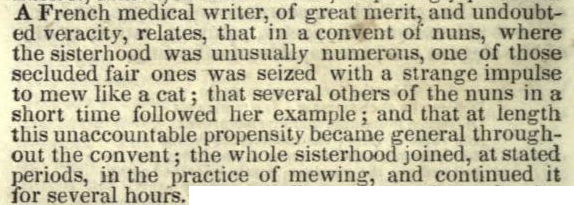The Murky Truth About the Meowing French Nuns

One day a nun living in a convent in France, sometime during the medieval period, began to meow like a cat. After a brief time, other nuns in convent began to meow with her in unison. The nuns were so loud that the sound carried to the town below, disturbing the residents with the bizarre sounds coming from the normally peaceful convent. After continuing for a number of days, police were brought in to cease the bizarre orchestra and were only able to do so by threatening to whip the offending nuns. The reason the first nun began to meow and why the other nuns decided to join remains a mystery.
… or at least, that’s how the story goes. If you’ve ever read about historical cases of ‘mass hysteria’, the meowing nun tale is just as likely to be referenced as the Dancing Plague of 1518. The idea of an outbreak of nuns trading their hymns for the sounds of wailing felines – especially in a medieval French convent – is not only creepy but it also feels like the premise of a film in the Conjuring universe. But where did this story come from? Do we have any proof that it actually happened?
More often than not, the ‘source’ of the account of the meowing nuns comes from The Epidemics of the Middle Ages published in 1844 in London. The work is a compilation of Justus Friedrich Carl Hecker’s three books The Dancing Mania (1832), The Black Death (1832), and The Sweating Sickness (1834), which were published in Berlin and written in the author’s native German. However, it is translator Benjamin Guy Babington and not Hecker that mentions our meowing nuns in a note under the section Hysteria in The Dancing Mania. In his note, Babington writes:

While we get a description of the ‘cat-concert’, the only reference to the actual location is a ‘very large convent in France’ and that the information was read in ‘a good medical work’. No date is mentioned, but since the translator felt it was relevant to the conversation on medieval epidemics I suppose we’re meant to assume it occured at some point between around 500 – 1500 CE. It isn’t out of the question that Babington did read about this case from a medical text at some point in his career. As the son of a physician, Babington studied medicine at Guy’s Hospital and Pembroke College, Cambridge where he received his doctorate in 1831. He lectured at the Royal College of Physicians and also acted as president of numerous medical societies. Based off his Translator’s Preface in The Epidemics of the Middle Ages, he had a keen interest in pandemics and was passionate about Hecker’s work. It’s just frustrating that he didn’t bother to cite whatever book or documentation he was referencing.
[As a side note, many articles online claim the ‘meowing-nun’ incident occured in 1844. This is not true and these articles are confusing the publication date of ‘The Epidemics of the Middle Ages’ with the actual date of the event (which is unknown).]
If we travel back roughly fifty years before The Epidemics of the Middle Ages we might find the name of Babington’s ‘good medical work’. Originally published in the 1780s, Swiss physician and philosopher Johann Georg Zimmermann’s Solitude examines the effects of isolation on the mind and the recommended balance between both solitude and society. In his chapter on ‘The Influence of Solitude on the Imagination’, our meowing nuns make an appearance:

… unfortunately, another dead end. This time the source is a ‘French medical writer, of great merit’ instead of Babington’s ‘good medical work’, but we’re no closer to finding the mysterious source of the meowing nuns or where exactly the incident occured. The story is told in almost the exact same way when comparing Babington and Zimmermann, so either Babington is making a vague reference to Zimmermann or both men are referencing the same medical text without bothering to name drop the author.
So there are a couple possibilities if we were to assume Zimmermann and Babington’s medical text exists:
- It’s buried in an academic library: If an old manuscript referencing the meowing nuns exists within a prestigious library or religious institution there’s a possibility it’s metaphorically gathering dust, waiting for someone to come along and translate it or make use of it in some way. But thanks to digitisation, millions of manuscripts that would have previously been locked away from the general public are now available online. So maybe sometime in the future it’ll surface and add some legitimacy to the story.
- It has been lost or destroyed: This is especially likely if the source was never copied. The amount of manuscripts that have been unintentionally and intentionally destroyed by fires, floods, earthquakes, vandalism, etc is upsetting to think about. It could also be rotting away in someone’s private collection.
I’m giving our meowing-nuns the benefit of the doubt. Could it have happened? Absolutely, it’s incredibly believable because human behaviour is strange and unpredictable. The meowing could have been a form of rebellion, a weird prank, or, as Zimmermann hypothesised, the influence of solitude on the mind. It’s difficult to make an educated guess of why the meowing would have started in the first place without knowing where exactly it happened and when. Perhaps the unknown medical writer shared his findings with Zimmermann in conversation but never went further with his study or wrote any of it down. It would be incredibly helpful if even the name of the abbey was known, but without that and the vague reference to it being in France (though this detail is only mentioned by Babington and not Zimmermann) there isn’t any way to prove whether or not this event actually took place.
There is also the possibility that Zimmermann fabricated the whole thing. On page 211 of Solitude he introduces the story of the meowing nuns with the eye-rolling statement “the female mind is still more subject to these delusions of disordered fancy; for, as their feelings are more exquisite, their passions warmer, and their imaginations more active than those of the other sex, solitude, when carried to excess, affects them in a much greater degree.” Creating a story of meowing nuns is a great way to drive his point home that women specifically have wild imaginations and delusions. It helps that he pairs the tale of the meowing nuns with an account of nuns biting each other all over Germany (also referenced by Babington), but that’s another story for another day.
But as no real proof of the meowing nuns exist, there’s also no proof Zimmermann was lying about them. Solitude is filled with examples of how isolation has effected the human mind throughout history, with many (but not all) of them citing specific incidents, people, and locations. It’s just a shame that our feline impersonators aren’t given the same curtesy. So unfortunately, this fascinating and creepy tale is – at present – nothing more than a fun story.
Sources and Additional Reading
Hecker, Justus Friedrich Carl. The Epidemics of the Middle Ages (1844).
Zimmermann, Johann Georg. Solitude (1840)

